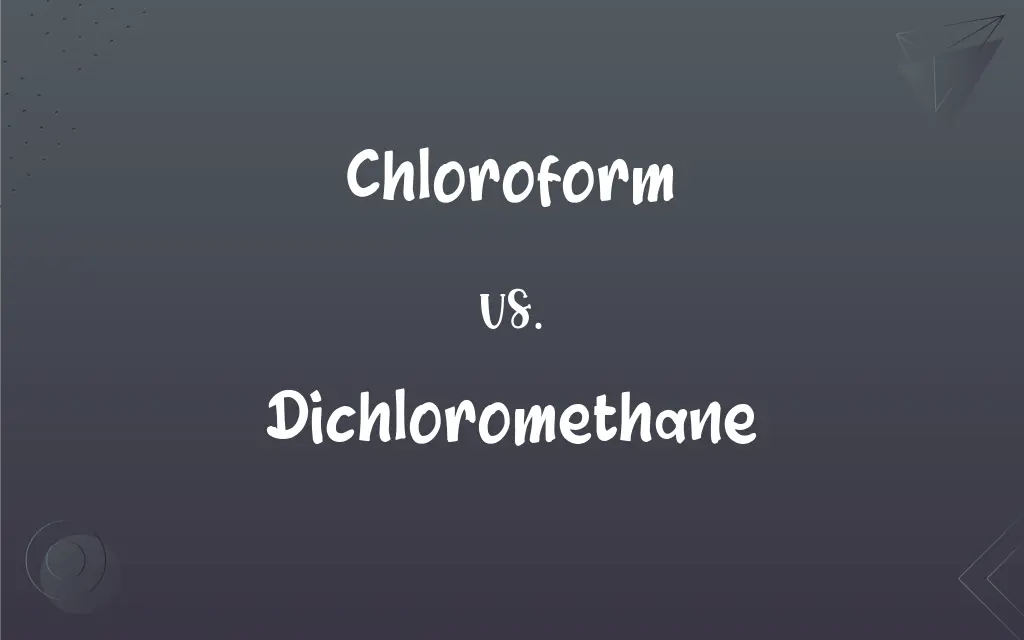Chloroform vs. Dichloromethane: What's the Difference?
Edited by Aimie Carlson || By Janet White || Published on January 2, 2024
Chloroform (CHCl₃) is a dense, sweet-smelling liquid used historically as an anesthetic. Dichloromethane (CH₂Cl₂) is a volatile, colorless liquid used primarily as a solvent.

Key Differences
Chloroform, with the formula CHCl₃, is known for its use in anesthesia and research. Dichloromethane (CH₂Cl₂), on the other hand, is primarily used as a solvent in laboratories and industries.
Chloroform is denser and has a higher boiling point than dichloromethane, making it less volatile. Dichloromethane evaporates more quickly due to its lower boiling point.
The historical use of chloroform includes anesthesia in surgeries, which has been discontinued due to safety concerns. Dichloromethane is often used in paint removers, pharmaceuticals, and film processing.
Chloroform's toxicity and potential to cause liver and kidney damage limit its applications. Dichloromethane, though less toxic, still poses health risks, especially in terms of its carcinogenic potential.
In the environment, chloroform can contribute to ozone layer depletion. Dichloromethane, while less harmful to the ozone layer, still impacts air quality due to its volatile nature.
ADVERTISEMENT
Comparison Chart
Chemical Formula
CHCl₃
CH₂Cl₂
Boiling Point
Higher boiling point
Lower boiling point
Primary Use
Historically as an anesthetic
Solvent in various industries
Volatility
Less volatile
More volatile
Toxicity and Safety
More toxic, liver and kidney damage
Less toxic, but carcinogenic concerns
ADVERTISEMENT
Environmental Impact
Ozone layer depletion
Air quality impact, less ozone impact
Chloroform and Dichloromethane Definitions
Chloroform
A dense, sweet-smelling liquid formerly used as an anesthetic.
Chloroform was a common anesthetic in the 19th century.
Dichloromethane
A volatile, colorless liquid used as a solvent.
Dichloromethane is commonly found in paint removers.
Chloroform
A chemical solvent with the formula CHCl₃.
Chloroform is used in laboratories to dissolve certain compounds.
Dichloromethane
Known for its lower boiling point compared to chloroform.
The low boiling point of dichloromethane allows it to evaporate quickly.
Chloroform
A compound known for its high boiling point.
The high boiling point of chloroform makes it stable in heat-intensive processes.
Dichloromethane
Used in industries like pharmaceuticals and film processing.
Dichloromethane is essential in the production of some pharmaceuticals.
Chloroform
A chemical contributing to environmental concerns like ozone depletion.
The release of chloroform into the atmosphere can negatively impact the ozone layer.
Dichloromethane
A compound with the chemical formula CH₂Cl₂.
Dichloromethane's molecular structure makes it effective for dissolving various materials.
Chloroform
A substance with historical medical applications but currently limited due to toxicity.
Despite its historical use, chloroform is now rarely used due to its toxic effects.
Dichloromethane
Less harmful to the ozone layer but still poses air quality concerns.
While not as damaging to the ozone, dichloromethane's volatility affects air quality.
Chloroform
A clear, colorless, dense, sweet-smelling liquid, CHCl3, used in refrigerants, propellants, and resins, as a solvent, and sometimes as an anesthetic. Chloroform, once widely used in human and veterinary surgery, has generally been replaced by less toxic, more easily controlled agents.
Dichloromethane
(organic compound) The partially halogenated hydrocarbon CH2Cl2 widely used as a solvent
Chloroform
To treat with chloroform to anesthetize, render unconscious, or kill.
Dichloromethane
A nonflammable liquid used as a solvent and paint remover and refrigerant
Chloroform
To apply chloroform to.
Chloroform
(organic compound) A halogenated hydrocarbon, trichloromethane, CHCl3; it is a volatile, sweet-smelling liquid, used extensively as a solvent and formerly as an anesthetic.
Chloroform
To treat with chloroform, or to render unconscious with chloroform.
Chloroform
A colorless volatile liquid, CHCl3, having an ethereal odor and a sweetish taste, formed by treating alcohol with chlorine and an alkali. It is a powerful solvent of wax, resin, etc., and is extensively used to produce anæsthesia in surgical operations; also externally, to alleviate pain.
Chloroform
To treat with chloroform, or to place under its influence.
Chloroform
A volatile liquid haloform (CHCl3); formerly used as an anesthetic;
Chloroform was the first inhalation anesthetic
Chloroform
Anesthetize with chloroform;
Doctors used to put people under by chloroforming them
FAQs
What is chloroform used for?
Historically used as an anesthetic, now limited to research.
What are the primary uses of dichloromethane?
Used as a solvent in various industries, including paint removal and pharmaceuticals.
Can chloroform be used as a solvent?
Yes, but its use is limited due to toxicity.
Is dichloromethane used in medical applications?
It is used in pharmaceutical manufacturing but not directly in medicine.
How does dichloromethane affect the environment?
It affects air quality due to its volatile nature.
Does dichloromethane have a lower boiling point than chloroform?
Yes, it has a lower boiling point, making it more volatile.
How is chloroform produced?
Typically through the chlorination of methane or chloromethane.
What is the chemical formula of chloroform?
CHCl₃.
Are there any health risks associated with dichloromethane?
Yes, including potential carcinogenic effects.
Is chloroform more toxic than dichloromethane?
Yes, chloroform is generally considered more toxic.
What safety precautions are needed when handling chloroform?
Use in a well-ventilated area and avoid inhalation or skin contact.
What is the environmental impact of chloroform?
It contributes to ozone layer depletion.
How is dichloromethane produced?
Mainly through the chlorination of methane gas.
Is chloroform still used in surgeries?
No, it's no longer used due to safety concerns.
Is dichloromethane naturally occurring?
It can occur naturally but is primarily industrial in origin.
Can chloroform be found in nature?
It can be produced in small amounts in natural processes.
What are the safety measures for dichloromethane?
Similar precautions: adequate ventilation and protection against inhalation and skin exposure.
Can chloroform be mixed with other chemicals?
It should be mixed carefully, considering its reactivity and toxicity.
Is dichloromethane reactive with other substances?
It can react with some chemicals, requiring careful handling in chemical reactions.
What is the chemical formula of dichloromethane?
CH₂Cl₂.
About Author
Written by
Janet WhiteJanet White has been an esteemed writer and blogger for Difference Wiki. Holding a Master's degree in Science and Medical Journalism from the prestigious Boston University, she has consistently demonstrated her expertise and passion for her field. When she's not immersed in her work, Janet relishes her time exercising, delving into a good book, and cherishing moments with friends and family.
Edited by
Aimie CarlsonAimie Carlson, holding a master's degree in English literature, is a fervent English language enthusiast. She lends her writing talents to Difference Wiki, a prominent website that specializes in comparisons, offering readers insightful analyses that both captivate and inform.






































































